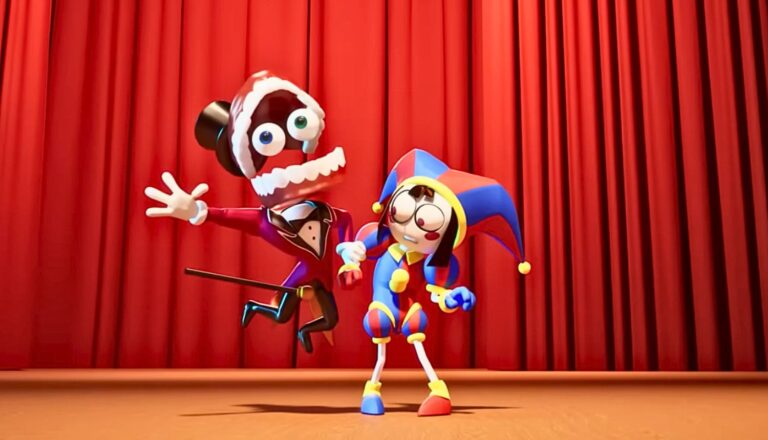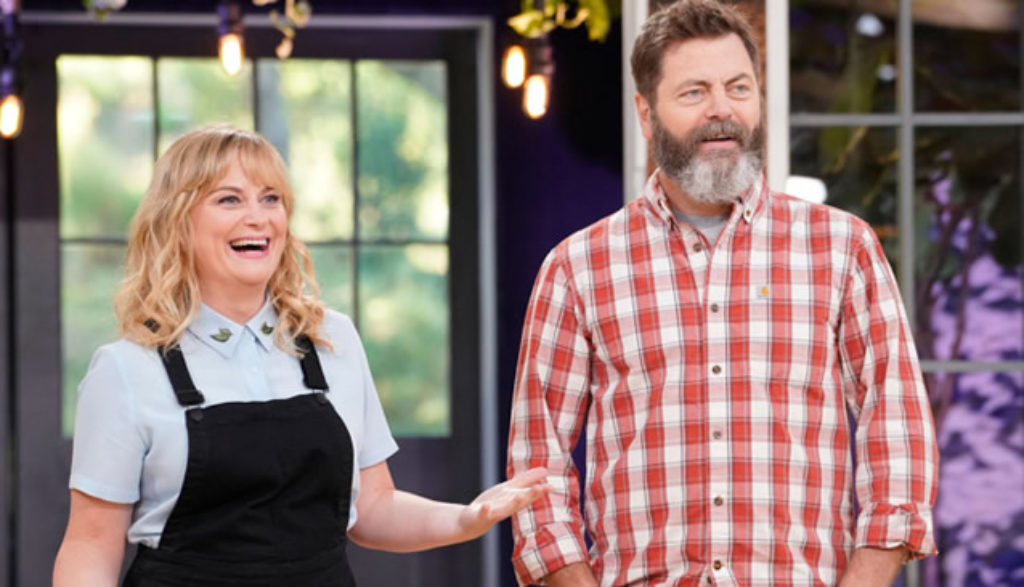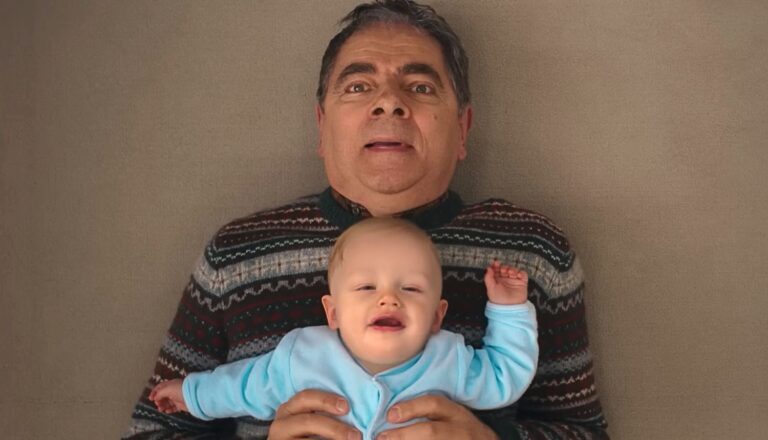
The Amazing Digital Circus
The Amazing Digital Circus places its digitized humans under the terrorism of a maniacal AI ringmaster and his chaotic adventures.

For seven seasons, Amy Poehler and Nick Offerman played the yin and yang of NBC’s Parks and Recreation. Poehler portrayed peppy Leslie Knope, a relentless, progressive optimist who originally hoped her stint as deputy director for Pawnee, Indiana’s Parks and Rec department would be one quick stop on the way to the White House. Offerman became Ron Swanson, a gruff libertarian (and Leslie’s boss) who believed crying was only acceptable “at funerals and the Grand Canyon.” They shared just two commonalities: a certain affinity for the citizens of Pawnee and a yen for scrambled eggs and pancakes.
“Why would anybody ever eat anything besides breakfast food?” Leslie asks Ron in Season 2.
“People are idiots, Leslie,” Ron tells her.
Parks and Rec ended its run in 2015, but Poehler and Offerman apparently weren’t tired of working with each other just yet. And with their new project at NBC—this one a reality series—the two actors show that, in real life, they have at least one more shared affection: crafting.
Not that Poehler knows a thing about crafting, other than the fact that it sometimes involves felt sheets and pipe cleaners. Offerman is the expert here: When not acting, the guy works with wood, and he’s pretty good at it, too. He even has his own woodshop website.
But they both appreciate good craftsmanship and the quirky people who engage in it.
“Making things connects people,” Poehler says in the first episode. “It’s like music or dance. There’s a universality about it that’s great.”
Poehler has said she wanted to “make a show that makes you feel good.” So naturally, Making It pits talented crafters against each other in a ruthless competition: In every episode, one hopeful artist is sent home in abject misery; only those with the sharpest pinking shears and quickest glue gun can hope to survive and claim the $100,000 grand prize.
Ron Swanson would be so proud. Call it survival of the craftiest.
OK, so I’m exaggerating a bit. Making It hardly comes across as a Darwinian eat-or-be-eaten competition. Yes, contestants are booted most every episode, because this is America and you can’t just have people crafting for the fun of it, can you? But Poehler, at least, wishes for a more utopian crafting society.
“Here’s a pitch,” she says to Offerman. “We don’t send anybody home. We add somebody every week. We all stay here, we look at cool stuff, we go to dinner.”
Offerman waits a beat. “I like dinner,” he says.
And the contestants are booted nicely, if such a thing is possible. The show’s first reject, a self-described hodgepodge crafter from Texas, sheds a few tears as she leaves … but then shares a glass of wine with Poehler and Offerman on the show’s picture-perfect porch.
Despite its standard-issue reality-show conceit, Making It wants to showcase not just excellent craftsmanship, but the value of community: How art can express not just our creativity, but who and what we value. It celebrates not just the end result, but the process that goes into making something. Even the weekly awards (not counting the flashy $100,000 grand prize) are charmingly antiquated: The winner of every competition gets an embroidered patch—suitable for sewing onto contestants’ old Junior Woodchucks vests, perhaps.
“Society has changed,” one contestant says. “People spend too much time on their phones. Why not take all of that energy and put it into real-life memories?”
But while the show celebrates old-fashioned craftsmanship and, by extension, traditional values of family and togetherness, society has changed. Those changes filter into the show, too.
Most reality shows take pains to represent the breadth of American society, and it’s rare to find one that doesn’t include a gay contestant or character. Making It is no exception. Judge Simon Doonan (the legendary window designer at New York City’s store Barneys) is openly gay, and contestants talk (sometimes tearfully) about same-sex relationships. The hosts aren’t above making a slightly off-color joke or ribald double entendre, either. And we might occasionally hear a mild profanity. Wine, as mentioned, makes an appearance or two as well.
NBC presents Making It as a wholesome family show—but one rooted in NBC’s own secular understanding of what family means, not a traditionally biblical one. With those caveats in mind, you’d be hard-pressed to find a reality show that feels quite as generous and well-meaning as this one. For families that are willing to work through the issues therein, Making It might make the cut.
(Editor’s Note: Plugged In is rarely able to watch every episode of a given series for review. As such, there’s always a chance that you might see a problem that we didn’t. If you notice content that you feel should be included in our review, send us an email at letters@pluggedin.com, or contact us via Facebook or Instagram, and be sure to let us know the episode number, title and season so that we can check it out.)
Offerman and Poehler welcome eight wood, paper, felt and hodgepodge crafters to NBC’s crafting barn. The first contest: The crafters must make a representation of an animal they feel represents something about themselves. Then the contestants jump into a two-part competition where they’re supposed to offer their own spin on traditional family heirlooms: quilts and photo albums. Offerman describes these heirlooms as things “to remember the people who came before them and the values they believed in.”
The show spends a few minutes getting to know Jeff, a paper crafter, who includes in his album a depiction of his husband, Albert. He tearfully unpacks how his family rejected him: “My parents were not happy with a gay son,” he says, and describes how one day at work he received a black funeral wreath that said, “In memory of my dead son.” He says that crafting is a “cheaper version of therapy.”
Another crafter creates a heart-shaped photo album out of wood, adding two silhouettes of her children at the bottom: “Because I love my kids at the bottom of my heart,” she explains.
When Poehler challenges Offerman to try to figure out what a given piece of wood is only by smell, a blindfolded Offerman rubs the piece of wood vigorously. “Do you want to be alone?” she asks him. We also hear one inappropriate use of God’s name. Outside of that, the worst language we hear is confined to “dang” and “shoot.”

Paul Asay has been part of the Plugged In staff since 2007, watching and reviewing roughly 15 quintillion movies and television shows. He’s written for a number of other publications, too, including Time, The Washington Post and Christianity Today. The author of several books, Paul loves to find spirituality in unexpected places, including popular entertainment, and he loves all things superhero. His vices include James Bond films, Mountain Dew and terrible B-grade movies. He’s married, has two children and a neurotic dog, runs marathons on occasion and hopes to someday own his own tuxedo. Feel free to follow him on Twitter @AsayPaul.

The Amazing Digital Circus places its digitized humans under the terrorism of a maniacal AI ringmaster and his chaotic adventures.

The self-centered hedonistic approach of every character in Emily in Paris only seems to increase, and the praises for it are doubled.

‘Little Disasters’ deals with child abuse and postpartum depression. But its other content concerns make it a bit of a disaster itself.

Man vs. Baby is a fun, heartwarming romp to enjoy with the whole family — preferably under a mountain of blankets with hot cocoa in hand.